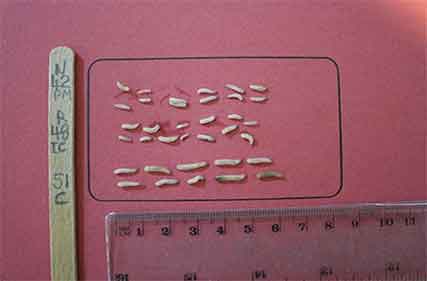
The difference in larvae growth after 72 hours between larvae exposed to the vaccine prototypes (top: native antigen vaccine; middle: recombinant antigen vaccine; and bottom: the control larvae, no vaccine) in laboratory tests.
By project leaders Tony Vuocolo (CSIRO) and Trent Perry, University of Melbourne
CSIRO is about to complete the first three-year phase of research on the development of a flystrike vaccine.
Much has been achieved in this time by extending our biological knowledge of the blowfly and identification of lead candidate protein antigens that have been tested in prototype vaccines.
But there is still a lot more work to do before we can translate our exciting results demonstrated in the laboratory into a well performing vaccine that can be used on-farm for flystrike prevention.
The following is a summary of progress to date as we move into a phase of on-sheep efficacy testing of the lead vaccine prototypes being performed at the current moment along with our plans going forward.
During the first phase we investigated the proteins that the blowfly larvae make as they grow from just hatching out of the egg phase to mature larvae that are approaching the pupation phase to turn into flies.
The availability of the blowfly genome that AWI and University of Melbourne were closely associated in developing was a very valuable tool in helping identify these genes and proteins.
From this analysis we were able to identify lead proteins that are now being targeted and produced as antigens for our vaccine. We shortlisted eight protein classes containing 35 candidate proteins and engineered and cloned these into bacteria or insect cells.
We use these cells as mini-factories to make the specific protein antigens, allowing us to then use these antigens for inclusion and formulation into vaccines.
We have made more than 50 prototype vaccines to date, vaccinating several hundred sheep and then tested all of these in the laboratory using serum from sheep. We are also keeping track and being informed about the potential implications of genome variations in the blowfly populations from around Australia by the population dynamics studies of the University of Melbourne (see following section).
From more than 50 prototype vaccines tested in the laboratory, we narrowed them down to two prototype vaccines that are being progressed to sheep-based larval challenges. In laboratory tests, these two vaccines were shown to reduce blowfly larvae growth rate by up to 75% (see the image below) and in some cases impact larval survival.
The challenge now will be duplicating these results on the sheep’s back. Unlike the ‘in laboratory tests’ with larval feeding assays undertaken under controlled conditions in the laboratory, where serum, rich in antibodies generated from the vaccine is available in abundance to the feeding larvae, the on-sheep testing represents a different and uncontrolled environment. Early results from two vaccine prototypes in sheep trials returned a 15% reduction in larval growth compared to 75% in the laboratory.
We are now working to better understand the sheep generated immune response and to optimise vaccine protocols and formulation to ensure the larvae are exposed to adequate levels of antibodies generated from the vaccine for it to be effective.
Once we are able to demonstrate the success of the vaccine prototypes in reducing larval growth on sheep, we plan to approach animal health companies who have shown keen interest in being involved to secure their commitment in developing and commercialising an effective and affordable flystrike vaccine.
-AWI
